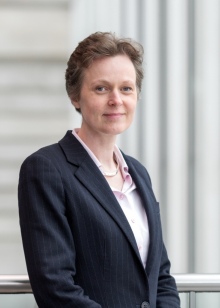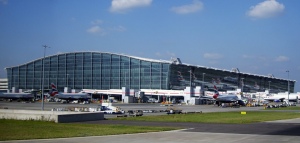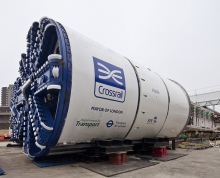

From the London 2012 Olympics to Crossrail, the management of mega infrastructure projects is being transformed by the smart use of digital assets.
The world of infrastructure is experiencing a radical transformation under the influence of digital technology. No longer is it an exclusively physical industry, but since the turn of the 21st century, has been experiencing a rapid fusion with cyberspace. As the sector’s demand for digitalisation expands, new research is imperative to deliver novel engineering solutions.
 Professor Jennifer Whyte (left), based in the Department of Civil and Environmental Engineering, is the Laing O’Rourke/Royal Academy of Engineering Professor of Systems Integration, and the Director of the Centre of Systems Engineering and Innovation. Her research focuses on the merging of physical and digital asset information, and the development of next generation tools and approaches for systems integration.
Professor Jennifer Whyte (left), based in the Department of Civil and Environmental Engineering, is the Laing O’Rourke/Royal Academy of Engineering Professor of Systems Integration, and the Director of the Centre of Systems Engineering and Innovation. Her research focuses on the merging of physical and digital asset information, and the development of next generation tools and approaches for systems integration.
Professor Whyte gave her inaugural lecture on Wednesday 25th May, titled “Starting with the End in Mind”, discussing her research into addressing the key challenges of systems integration in infrastructure.
“As we move into a data-rich world we are faced by many challenges,” explained Jennifer. “Technology is moving forward much more rapidly than the underlying infrastructure.”
She presented the audience with the value of starting with the end in mind: “By looking at the ends and outcomes of complex projects we might be able to better understand how we set projects up, what issues emerge during project delivery, and the intrinsic issues of project end, such as commissioning and handover. We need to consider design for manufacture, design for assembly, and design for operation.”
Jennifer advocated the use of classic V-diagrams in the early stages of project development. This conceptual model, designed to simplify the lifecycle of projects, illustrates the levels of progression from the investment decision to the final operations and maintenance.

Heathrow T5
Jennifer’s research with the London 2012 Olympics focused on data handovers between teams. She uses the analogy of a baton-pass in a relay race to illustrate the training and communication skills necessary to a fast and fluid handover. “Systems integration has resulted in teams from many more disciplines of engineering having to work together in infrastructure, and there’s been little research on coordination between these teams,” she said. “At the London 2012 Olympics I looked at how they ‘passed the baton’ to owners and operators, to better understand how to improve digital data handovers to ultimately manage the built infrastructure.”
 Throughout the Crossrail project, Jennifer and her team tested a 3D-Mobile visualisation environment in Crossrail’s system-wide offices. Playing a high-speed recording of the 30 minute set-up, Jennifer explained: “By bringing clients into virtual reality projects they can collectively visualise areas of concern, such as design or construction issues. The value of using a virtual reality built environment means that engineers can navigate the model together.” This method of project visualisation evoked very positive feedback from Victoria and Bond Street stations. Jennifer is currently rewriting her book related to this research.
Throughout the Crossrail project, Jennifer and her team tested a 3D-Mobile visualisation environment in Crossrail’s system-wide offices. Playing a high-speed recording of the 30 minute set-up, Jennifer explained: “By bringing clients into virtual reality projects they can collectively visualise areas of concern, such as design or construction issues. The value of using a virtual reality built environment means that engineers can navigate the model together.” This method of project visualisation evoked very positive feedback from Victoria and Bond Street stations. Jennifer is currently rewriting her book related to this research.
Jennifer also spoke of her experience at the Terminal 5 roof sub-project, in which her team looked at a digital model of varying roof designs, before implementing these into the physical structure itself. “We have to bear in mind that these models must be movable from digital structure to the real world. Keeping the requirements, physical assets, and the digital assets connected was imperative in managing complex projects.”
Jennifer concluded the lecture with her future plans to improve our understanding of systems integration, and to lead a broader programme of research as Director of the Centre for Systems Engineering and Innovation: “Further research is needed to improve the way we visualise and understand interdependencies in the industry. We work by engaging industry partners to understand real-world problems. Our approach is to work with leading engineers and managers, bringing learning back to the lab to develop next generation solutions, and seeing ourselves as part of a broader innovation ecosystem.”
View the recording of Professor Jennifer Whyte’s inaugural lecture here.
Article text (excluding photos or graphics) available under an Attribution-NonCommercial-ShareAlike Creative Commons license.
Photos and graphics subject to third party copyright used with permission or © Imperial College London.
Reporter
Melanie Hargreaves
Department of Civil and Environmental Engineering




Leave a comment
Your comment may be published, displaying your name as you provide it, unless you request otherwise. Your contact details will never be published.